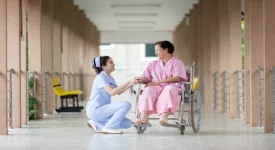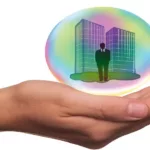Today, more than eight million people receive support from long-term care services in the United States. Home health agencies, nursing homes, residential care communities, and adult daycare services provide care to millions and that number is expected to grow in the future. As more and more reach retirement age, the senior care industry is making fundamental changes to accommodate shifting needs. The senior care industry is expected to grow 38.8% by 2020, encouraging these facilities make improvements that fit shifting demographics.
Person-Centered Care
Increasingly, senior care staff are recognizing the importance of focusing on resident’s individual needs. Largely, residents are given more options and control over the planning and decision-making in their care plan. Staff members are encouraged to develop in-depth relationships with residents while striving to learn and understand their preferences and needs. This initiative goes above and beyond with several key characteristics:
- Consistent Staff Assignments: Staff members are assigned to specific residents to enhance relationships and grow trust. Residents and staff both report feeling happier while incidents of illness, infection, hospitalization, and injury decrease. Staff are able to detect gradual changes in health and residents benefit from feelings of respect, friendship, choice, and safety.
- Diversified Activities and Programs: As the staff takes more time to understand residents, many facilities are offering a large variety of entertainment that caters to countless cultures and tastes. Facilities are now offering personalized culinary experiences, enhanced activities for well-being, and initiatives for meaningful socialization. Examples include: water aerobics, yoga, music classes, painting, gardening, computer education, videogames, trivia, cookouts, and more.
- Care Coordination: Senior care communities recognize the difficulty of coordinating care. Between chronic health conditions and physical disabilities, it has become important to integrate clinical care with support systems. In addition to physical therapy rooms, senior care staff actively track information on medications, treatment efficacy, timeliness of services, coordination of appointments, and more. Ultimately, these initiatives allow staff to better communicate on processes of care while providing consistent health education.
Removing Signs of an Institutional Setting
Traditional images of a senior care facilities often feature a hospital-like setting with a nurse’s station and med carts to service residents. Modern facilities are aiming to transform common spaces into areas where seniors can better enrich their lives. Staff members are no longer separated from residents by desks or carts, these new spaces allow for better support and more activity.
- Personalized Living Spaces: Traditional senior care communities have offered a variety of furnished and unfurnished choices that can meet most needs yet the future is demanding more. Senior care communities are recognizing the need for personalization by offering more amenities and options as residents convert a place into a home. Facilities are now offering choices in décor, walk-in closets, larger bathrooms, full kitchens, and areas for entertaining. Residents can select furnished units or bring furniture from their own home. Many also offer peaceful outdoor areas with gardens and gathering spaces.
- Sensory Considerations: Care communities are remodeling with the five senses in mind. Many are redesigning their facilities with high-quality, energy efficient lighting that provides aesthetic yet accommodates older eyes. The staff are more cognizant of noise levels with quieter calls, carts, and phone calls. Facilities are also using aromatherapy atomizers and green cleaning supplies to provide pleasant smells and relaxation.
- Spaces for Support: Senior care communities are additionally committed to providing amenities and shared spaces for seniors. On-site libraries, computer labs, and classrooms allow seniors to educate themselves; mediation rooms and communal worship areas permit religious/spiritual expression of all kinds. Many facilities feature gymnasiums or workout rooms, others offer spas or swimming pools for exercise. A prominent trend in senior care is a movement for facilities to acknowledge personal preferences and provide services that tailor-fit their resident’s needs.
Technology
Technology is pervasive in our culture and more seniors are becoming tech savvy. Common devices, such as the tablet or smart home, can benefit senior care facilities enormously. Electronic medical systems allow healthcare providers to streamline services by scheduling appointments, maintaining medications, coordinating providers, and creating comprehensive file systems. Many medical professionals use tablets to mobilize care but increasingly more facilities are increasing resident access to mobile devices.
- WIFI: Commonly care communities are offering wireless internet throughout their facilities. Wireless access allows caregivers to provide mobile care to any area while residents can access applications no matter where they are.
- Mobile Devices: Laptops and tablets are being given to residents to allow them more control over their care planning. Seniors can connect with loved ones, schedule appointments, download learning apps, and much more.
- Specific Classes: Many facilities offer computer classes but other have gone further. Staff and community volunteers frequently offer classes that can teach seniors how to use social media, Skype, and even dating apps.
- Smart Home: Most tablets are capable of using smart home technology. Some care facilities now offer smart home services that allow residents to make lists, control their lights, set security alarms, manage other devices, and much more.
Memory Care
Memory care is a unique branch of long-term care intended to help those struggling with significant cognitive decline. As more baby boomers retire, senior care communities are seeing an impressive demand for memory care services. Recent trends indicate a substantial increase in demand and long-term care communities are responding.
- Design: Distinct building designs and additional security are a few examples of features that benefit those with memory-related disorders. Hallways are often planned in a circular design to prevent wandering with iconic symbols to help residents find their way. Memory boxes or walls are built to help personalize spaces and trigger memory. Some communities are even reviving 1950-60’s style to immerse seniors in a familiar setting of their youth.
- Sensory Considerations: Similar to other care facilities, memory care communities are focused on the effects of a sensory-conscience environment. Memory care commonly offers a room that combines high levels of lights, colors, smells, sounds, and textures. Known as Snoezelen rooms, this therapeutic environment stimulates the senses in order to trigger memory. Many report better communication and understanding of their environment, as well as improved mood and enhanced self-esteem.
Across the nation, countless organizations and groups are dedicating themselves to meeting the challenges of these trends. Vast improvements in the construction and redesign of long-term care communities is only the beginning. These dramatic trends will forever alter the image of long-term care from a hospital to a place for comfortable living and continuous support.
Author Bio : Joey Clayton works for Senior Advisor who provide senior care reviews and assisted living depth analysis and details.








